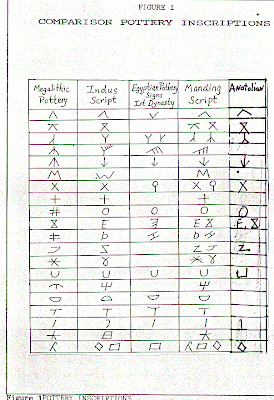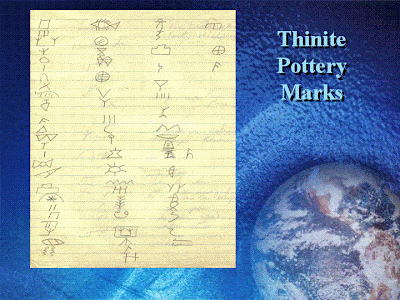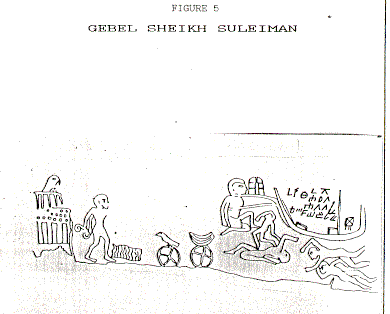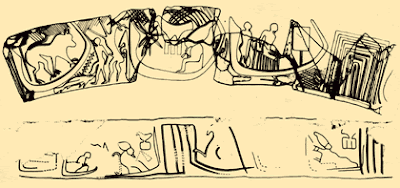Recently Edwin van den Brink provides a detailed discussion of pot marks dating to the Thinite period from Lower and Upper Egypt. There is continuity between these signs from the Thinite period through Dynaties O and I down to the Saharan/Libyco-Berber rock inscriptions and Vai Syllabary.
Although it is alleged that Africans were always illiterate, archaeological, historical, and epigraphic evidence indicate that Africans invented many writing systems. And that these writing systems were used from ancient times all the way up to the present (Bekerie 1994).The original inhabitants of the Sahara where the Egyptian or Kemitic civilization originated were not Berbers or Indo-Europeans (Winters 1985b). This was the ancient homeland of the Dravidians, Egyptians, Sumerians, Niger-Kordofanian-Mande and Elamite speakers is called the Fertile African Crescent (Anselin 1989, p.16, 1992; Winters 1981,1985b,1989, 1991,1994).The inhabitants of this area lived in the highland regions of the Fezzan in modern Libya and Hoggar until after 4000 B.C. We call these people the Proto-Saharans (Winters 1985b, 1991). The generic term for this group is Kushite.
The Proto-Saharans were called Ta-Seti and Tehunu by the Egyptians. In the archaeological literature they were called A-Group and C-Group respectively. Farid (1985, p.82) noted that:We can notice that at the beginning of the neolithic stage in Egypt on the edge of the Western Desert corresponds with expansion of the Saharian Neolithic culture and the growth of its population .The Fertile Saharan Crescent is an arc shaped series of highland regions in the Saharan zone of Africa. The Saharan zone is bounded on the north by the Atlas mountains, the Atlantic Ocean in the West, the tropical rain forest in the south and the Red Sea in the East.
It was here that the ancestors of the founders of the river valley civilizations in Africa, the Middle East, China and Indus Valley developed their highly organized and technological societies (Winters 1983a, 1985b). The discovery of Intercultural style vessels from Susa (in Iran),Sumerian, Egyptian and Indus Valley sites suggest a shared ideological identity among these people (Kohl 1978). In fact the appearance of shared iconographic symbols and beliefs within diverse areas suggest cultural and ethnic unity among the people practicing these cultures. The common naturalistic motifs shared by the major civilizations include, writing (symbols), combatant snakes , the scorpion, bull and etc. This evidence of cultural unity is explained by the origin of these people in the Proto-Sahara (Winters 1985a, 1989).
The Proto-Saharans or Kushites used similar terms for writing. In general the term for writing was formed by the labial stops /p/ and /b/. For example:
Dravidian par 'write'
Manding bo, bu 'make a stroke', sebe 'write'
Elamite tipu 'to write'Galla tafa 'to write'
There are also other corresponding terms for 'mark', or 'draw' that begin with velar stops:
Dravidian kiri, kuri 'write, draw, mark'
Egyptian hti 'carve'
Manding kiri, kiti 'mark'
In Egyptian we have several terms for write 0 ss #, 0 zs # , and 0 ssw #. During the Old Kingdom writing was referred to as 0 iht # .The Egyptian term for writing 0 ssw # is analogous to the Mande terms 0 sewe # or 0 sebe # 'writing, trace, design'.
In Dravidian among other terms we have rasu 'write', and shu 'writing' in Sumerian. The Egyptian term 0 zs # is also closely related to Sumerian 0 shu #.
Writing systems among African people were mainly devised for two purposes. Firstly, to help merchants keep records on the business venture they made. Secondly, the Proto-Saharan script was also used to preserve religious doctrines or write obituaries.The scarcity of documents, written for historical preservation among ancient African groups resulted from the fact that the keeping of history, was usually left in the hands of traditional (oral) historians. These historians memorized the histories of their nation and people for future recitation before members of their respective communities. This oral history was often accompanied by music or delivered in poetic verse and remains the premier source for the history of most African nations even today.It is obvious that the first inscriptions were engraved in stone by the Proto-Saharans , or a stylus was used to engrave wet clay (Winters 1985b).
The use of the stylus or stick to engrave clay is most evident in the pottery marks found on the pottery excavated at many ancient sites which possess similar symbols impressed on the pottery.This view is supported by the fact that the term for writing in Dravidian and Egyptian include the consonants /l/, /r/ or /d/.A "u", is usually attached to the initial consonants (Winters 1985b).
For example:
Sumerian ru, shu
Elamite talu
Dravidian carru
Egyptian drf
These terms agree with the Manding terms for excavate or hollow out 0 du #, 0 do #, 0 kulu #, 0 tura #, etc. The Sumerian term for writing was 0 du #.
This show that the Proto-Saharan term for writing denoted the creation of impressions on wet clay and hard rock.The origin of writing among the Proto-Saharans as an activity involving the engraving of stone is most evident in the Egyptian language. This hypothesis is supported by the Egyptian words 0 m(w)dt #. The term 0 md t # means both '(sculptor's) chisel' and 'papyrus-roll, book'. The multiple meanings of 0 md t # makes it clear that the Egyptian, and probably other descendants of the Proto-Saharans saw a relationship between engraving stone and the creation of books.
Other Egyptian lexical items also support the important role Proto-Saharans saw in engraving rocks, and writing. In addition to md t we have, 0 hti # 'carve, sculpture' and 0 iht # 'writing'.
The fact that iht is an Old Kingdom term for writing, almost identical to hti, is further evidence that writing involved the engraving of stone.POTTERY INSCRIPTIONSThe Proto-Saharan writing was first used to write characters on pottery (Winters 1980), to give the ceramics a talismanic quality .

Similar signs appear on Chinese, Harappan, South Indian Megalithic, Libyan and Cretan pottery (see figure 1). These signs were invented by the Proto-Saharans for purposes of communication. These pottery signs agree with the so-called linear Egyptian signs mentioned by Petrie (1921, p.83). They frequently appear on Egyptian pottery .
The Egyptian pot marks in Upper and Lower Egypt. Petrie (1900) was the first to record the Egyptian potmarks. These potmarks are found on pottery dated to Dynasties O to I (van den Brink 1992). These Thinite potmarks published by van den Brink (1992) agree almost totally with the Oued Mertoutek, Gebel Sheikh Suleiman, Harappan, Proto-Elamite and Proto-Sumerian (see figure 3).

It is clear that a common system of record keeping was used by people in the 4th and 3rd millennium B.C. from Saharan Africa, to Iran, China and the Indus Valley. Although the Elamites and Sumerians abandoned the Proto-Elamite writing and the Uruk script respectively, in favor f cuneiform writing, the Dravidians, Minoans (EteoCretans) and Manding continued to use the Proto-Saharan script (see figure 2) (Winters 1985c).The pottery signs were symbols from the Proto-Saharan syllabic writing. David (1955) was sure that the Dravidian and Cretan writings were analogous to the Egyptian pottery script.Moreover Dr. J.T. Cornelius (1956-57) used epigraphic evidence to show that the graffiti marks on the South Indian Megalithic pottery has affinity to other ancient scripts including the Libyan, Egyptian and Cretan signs.The languages of the Dravidians, Elamites, Sumerians and Manding are genetically related (Winters 1985d, 1989b, 1994). N. Lahovary (1957) noted structural and grammatical analogies of Dravidian, Sumerian and Elamites. K.L. Muttarayan (1975) provides hundreds of lexical correspondences and other linguistic data supporting the family relationship between Sumerian and Dravidian. C. A. Winters (1980, 1985d, 1989b, 1994) and L. Homburger (1951) have provided evidence of a genetic relationship between the Dravidian languages and the Manding Superset of languages. Dr. Homburger has also proven that the Manding and Coptic languages are closely related. The oldest Proto-Saharan inscriptions come from Oued Mertoutek and Gebel Sheikh Suleiman. These inscriptions are over 5000 years old (Wulsin 1941; Winters 1983a ).Here pictures of the Gebel Shaikh Suleiman relief from Arkell (1961, p.39) and Hinkel, 1978, photo between pp.56-57) are published as you can see they are found above boat.
http://www.geocities.com/ahmadchiek/Slide2.GIFThe presence of the same inscriptions found on the pots, recorded on the Gebel Shaikh Suleiman relief make it clear that these marks were not only engraved on pottery they also were engraved on rocks.
References:
Arkell,A.J. (1961). A History of the Sudan. University of London.
Hinkel,F.W. (1978). Exodus from Nubia. Berlin: Akademie-Verlag.
Patrie,W.M.F. (1900). The Royal Tombs of the First Dynasties. London: EES.
Van de Brink, Edwin C.M. . (1992) Corpus and numerical evaluation of the Thinite Potmarks. In The Followers of Horus: Studies Dedicated to Michael Allen Hoffman. Egyptian Studies Association Publication, No.2: pp.265-296.Oxford: Oxbow Books.
 Williams (1987) and Trigger (1980) have failed to discuss the entire inscription on the Gebel Sheikh Suleiman relief. These scholars ignore the Proto-Saharan inscription, and describe only, the relief from left to right as follows: a serekh topped by a falcon looking over a victorious battlefield, sacred bark and a bound prisoner .
Williams (1987) and Trigger (1980) have failed to discuss the entire inscription on the Gebel Sheikh Suleiman relief. These scholars ignore the Proto-Saharan inscription, and describe only, the relief from left to right as follows: a serekh topped by a falcon looking over a victorious battlefield, sacred bark and a bound prisoner .


